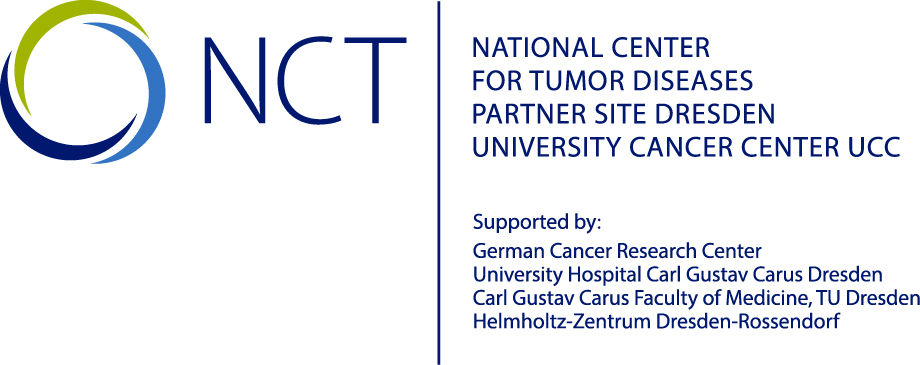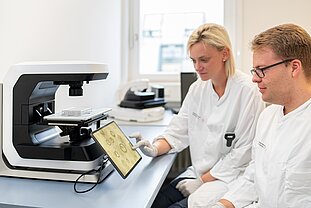Gastric cancer patients whose tumors show increased activation of the MAPK signaling pathway could benefit in future from a novel treatment with targeted drugs. These are the findings of laboratory experiments conducted by an international research team led by scientists from University Hospital Carl Gustav Carus in Dresden, the Spanish National Cancer Research Centre (CNIO), University Hospital Düsseldorf and the National Center for Tumor Diseases Dresden (NCT/UCC). The efficacy of the drugs, which have not previously been used to treat gastric cancer, was demonstrated both in 3D cell models derived from animal cells with clearly defined genetic characteristics and in patient-derived cell models.
The National Center for Tumor Diseases Dresden (NCT/UCC) is a joint institution of the German Cancer Research Center (DKFZ), University Hospital Carl Gustav Carus Dresden, the Faculty of Medicine Carl Gustav Carus of TU Dresden and the Helmholtz-Zentrum Dresden-Rossendorf (HZDR).
Gastric cancer is the fifth most commonly diagnosed cancer in the world, and the third leading cause of cancer deaths worldwide. Since at first there are hardly any symptoms, the disease is often only diagnosed once it has reached an advanced stage. Local-stage stomach cancer is usually treated with surgery and accompanying chemotherapy. Patients with distant metastases are treated exclusively with drugs. Targeted therapies that target specific genetic changes in the tumor are rarely used because of the wide range of possible changes in the tumor genome.
Now, an international team of researchers has shown in laboratory experiments that gastric tumors exhibiting activation of the MAPK signaling pathway respond particularly well to targeted anti-cancer agents from the HDAC inhibitors class. Treatment with these drugs, which have not previously been used to treat gastric cancer, could in future improve therapy options for patients whose tumors exhibit changes in the MAPK signaling pathway.
The mitogen-activated protein kinase (MAPK) pathway is one of the most commonly overactivated signaling pathways in stomach cancer, and leads to an increased division of tumor cells. As Prof. Daniel Stange, a senior physician and research group leader in the Department of Visceral, Thoracic and Vascular Surgery (VTG) at University Hospital Dresden, explains, “The MAPK signaling pathway is deregulated in around 40 percent of gastric cancer patients. If the results of the translational research are confirmed in the clinic, the identified drugs could in future lead to improved therapy response and better control of the disease compared with previous standard treatments.”
As Prof. Michael Albrecht, Medical Director of University Hospital Dresden, emphasizes, “Cancer is a very individual disease. That is why advances in personalized oncology are so important – where treatment is tailored as precisely as possible to the biological characteristics of the individual tumor.”
For their study, the researchers used 3D cell culture systems, known as organoids, from animal stomach cells and patient-derived tumor cells. In order to make the results easier to interpret, the animal organoids had clearly defined mutations and reflected changes in important cell signaling pathways that are typical of various subtypes of stomach cancer (according to the Cancer Genome Atlas). The scientists used these cell models to test the mechanism of action of 196 different substances.
An organoid model in which the MAPK signaling pathway was overactivated by a targeted mutation in the KRAS gene showed a much better response to HDAC inhibitors. This group of drugs can influence deregulation of histone deacetylases (HDACs), an enzyme family that is commonly deregulated in cancer cells, and restrain the growth of tumor cells.
To check whether this susceptibility to HDAC inhibitors also applies to human tumors, the researchers extended their analysis to 13 genetically more heterogeneous patient-derived gastric cancer organoids. Seven of them exhibited activation of the MAPK signaling pathway. Six of the seven MAPK-activated organoids were found to be sensitive to HDAC inhibitors, while five of the six tumor organoids without MAPK signaling pathway activation showed considerable resistance to HDAC inhibitors.
In addition to the sensitivity to HDAC inhibitors, both the animal and patient-derived organoids with overactivated MAPK signaling pathway exhibited increased response to another active substance – the MEK inhibitor trametinib. Trametinib targets the MAPK signaling pathway directly and inhibits MEK, a protein kinase that is important for signal transmission.
Prof. Jürgen Weitz, Director of the VTG Department at University Hospital Dresden and a member of the Managing Directorate of the NCT/UCC, explains: “A combined therapy with both drugs looks particularly promising for potential clinical use. Combination therapies are less vulnerable to drug resistance. Moreover, the dosage of individual active substances in combination therapies can often be reduced compared with single-drug therapies, without reducing the efficacy. This often results in fewer side effects for patients.”
In future, the researchers plan to find answers to further questions concerning the mechanism of action and choice of drugs in the laboratory. “Although the mechanism of action of trametinib in activated MAPK signaling pathway is clear, the relationship between activation of this signaling pathway and the improved efficacy of HDAC inhibitors is not yet sufficiently well understood,” says Dr. Therese Seidlitz, a co-first author of the study and a researcher in the VTG Department of University Hospital Dresden. “One of our next research projects will be to investigate this relationship in greater detail.” Co-first author Tim Schmäche, another researcher in the VTG Department of University Hospital Dresden, adds: “In addition, we want to understand better why different HDAC inhibitors appear to vary in efficacy in different patient-derived tumor organoids. Once these questions have been answered, patients could benefit from HDAC inhibitors in clinical trials.”
Publication:
T. Seidlitz, T. Schmäche, F. Garcίa et al. Sensitivity towards HDAC inhibition is associated with RTK/MAPK pathway activation in gastric cancer. EMBO Mol Med (2022)e15705 https://doi.org/10.15252/emmm.202215705
A print-quality photo is available to accompany the press release:
https://www.nct-dresden.de/fileadmin/media/nct-dresden/das-nct/newsroom/pressemitteilungen/Organoid-Magenkrebs.jpg
Caption: Researchers analyze the structure of an organoid under a light and fluorescence microscope. © University Hospital Dresden/Kirsten Lassig
Notice of use for image material for press releases
Usage is free. The NCT/UCC Dresden permits one-time use in connection with reporting on the topic of the press release. Please enter the copyright Uniklinikum Dresden/Kirsten Lassig. The image material may only be passed on to third parties after prior consultation with NCT/UCC Communications (phone: +49 351 458 5548, e-mail: anna.kraft@nct-dresden.de). Use for commercial purposes is prohibited.
Press contact:
Dr. Anna Kraft
National Center for Tumor Diseases Dresden (NCT/UCC)
Press and Public Relations
Tel: +49 (0)351 458-5548
E-mail: anna.kraft@nct-dresden.de
www.nct-dresden.de
Dr. Sibylle Kohlstädt
German Cancer Research Center (DKFZ)
Strategic Communications and Public Relations
Tel.: +49 (0)6221 42-2854
E-mail: s.kohlstaedt@dkfz.de
www.dkfz.de
Stephan Wiegand
Public Relations & Marketing Department
Carl Gustav Carus Medical Faculty of Dresden University of Technology
Tel.: +49 (0) 351 458-19389
E-mail: stephan.wiegand@tu-dresden.de
www.tu-dresden.de/med
Holger Ostermeyer
University Hospital Carl Gustav Carus Dresden
Press Office
Tel.: +49 (0)351 458 41 62
E-Mail: Pressestelle@uniklinikum-dresden.de
www.uniklinikum-dresden.de
Simon Schmitt
Communication and Media | Management and Press Spokesman
Helmholtz-Zentrum Dresden-Rossendorf
E-Mail: s.schmitt@hzdr.de
Tel.: +49 351 260-3400
www.hzdr.de
National Center for Tumor Diseases Dresden (NCT/UCC)
The National Center for Tumor Diseases Dresden (NCT/UCC) is a joint institution of the German Cancer Research Center, the Carl Gustav Carus Faculty of Medicine at TU Dresden, the Carl Gustav Carus University Hospital Dresden and the Helmholtz-Zentrum Dresden-Rossendorf (HZDR).
The NCT has made it its duty to closely link research and patient care wherever possible. That is why cancer patients at the NCT sites can be treated based on the latest research results. At the same time, the proximity of laboratory and clinic provides researchers with important impulses for their practice-oriented research. The NCT sites share the common goal of developing the NCT into a top international center for patient-oriented cancer research. The Dresden center draws on the structures of the University Cancer Center Dresden (UCC), which was founded in 2003 as one of the first Comprehensive Cancer Centers (CCC) in Germany. Since 2007, the UCC has been honored by the German Cancer Aid e.V. (DKH) as a "Top Oncological Center" on a continuous basis.
German Cancer Research Center (Deutsches Krebsforschungszentrum, DKFZ)
The German Cancer Research Center (Deutsches Krebsforschungszentrum, DKFZ) with its more than 3,000 employees is the largest biomedical research institution in Germany. More than 1,300 scientists at the DKFZ investigate how cancer develops, identify cancer risk factors and search for new strategies to prevent people from developing cancer. They are developing new methods to diagnose tumors more precisely and treat cancer patients more successfully. The DKFZ's Cancer Information Service (KID) provides patients, interested citizens and experts with individual answers to all questions on cancer.
Jointly with partners from the university hospitals, the DKFZ operates the National Center for Tumor Diseases (NCT) in Heidelberg and Dresden, and the Hopp Children's Cancer Center KiTZ in Heidelberg. In the German Consortium for Translational Cancer Research (DKTK), one of the six German Centers for Health Research, the DKFZ maintains translational centers at seven university partner locations. NCT and DKTK sites combine excellent university medicine with the high-profile research of the DKFZ. They contribute to the endeavor of transferring promising approaches from cancer research to the clinic and thus improving the chances of cancer patients.
The DKFZ is 90 percent financed by the Federal Ministry of Education and Research and 10 percent by the state of Baden-Württemberg. The DKFZ is a member of the Helmholtz Association of German Research Centers.
University Hospital Carl Gustav Carus Dresden
The University Hospital Carl Gustav Carus Dresden offers medical care at the highest level of care. As a full-service hospital, it covers the entire spectrum of modern medicine. The University Hospital combines 20 clinics and outpatient departments, four institutes and ten interdisciplinary centers that collaborate closely with the clinical and theoretical institutes of the Faculty of Medicine.
With 1,295 beds and 160 places for day-care treatment, the Dresden University Hospital is the largest hospital in the city and also the only full-service hospital in eastern Saxony. Around 860 doctors cover the entire spectrum of modern medicine. 1,860 nurses and caregivers ensure the patients' well-being. The medical care of patients suffering from cancer, metabolic and neurodegenerative diseases is an important focus of treatment at the University Hospital.
Germany's largest hospital comparison by the news magazine "Focus" confirms that the University Hospital Carl Gustav Carus Dresden provides an excellent quality of treatment. That is why Dresden's university medicine comes second in the Germany-wide ranking.
Carl Gustav Carus Faculty of Medicine at Technische Universität Dresden
The Dresden University Medicine, consisting of the Carl Gustav Carus Faculty of Medicine and the university hospital of the same name, has specialized in research in the fields of oncology, metabolic as well as neurological and psychiatric diseases. Within these focal areas, the topics of degeneration and regeneration, imaging and technology development, immunology and inflammation, as well as prevention and health care research are of particular interest. International exchange is a prerequisite for top-level research - the Dresden University Medical Center embraces this concept with employees from 73 nations and numerous collaborations with researchers and teams from all over the world.
Helmholtz-Zentrum Dresden-Rossendorf (HZDR)
The Helmholtz-Zentrum Dresden-Rossendorf (HZDR) conducts research in the fields of energy, health and matter. It focuses on the following questions:
• How can energy and resources be used in an efficient, safe and sustainable way?
• How can cancer be better visualized, characterized and effectively treated?
• How do matter and materials react under the influence of strong fields and in smallest dimensions?
To answer these scientific questions, the HZDR operates large infrastructures that are also used by external measurement guests: Ion Beam Center, High Field Magnetic Laboratory Dresden and ELBE Center for High Power Radiation Sources.
The HZDR is a member of the Helmholtz Association, has five sites (Dresden, Freiberg, Grenoble, Leipzig, Schenefeld near Hamburg) and employs almost 1,200 people - about 500 of whom are researchers including 170 PhD students.







